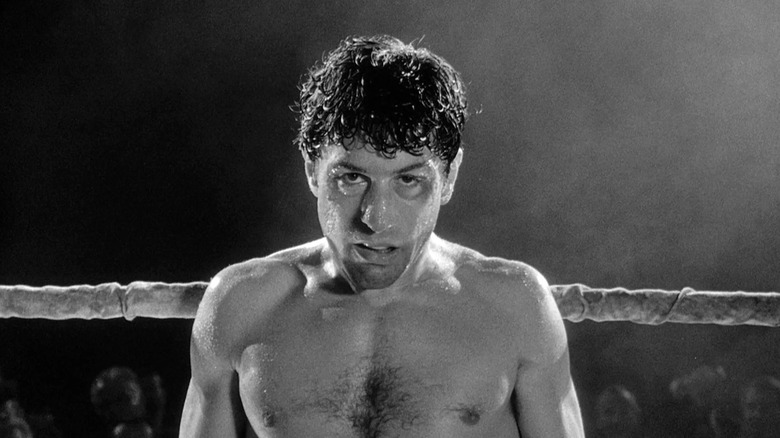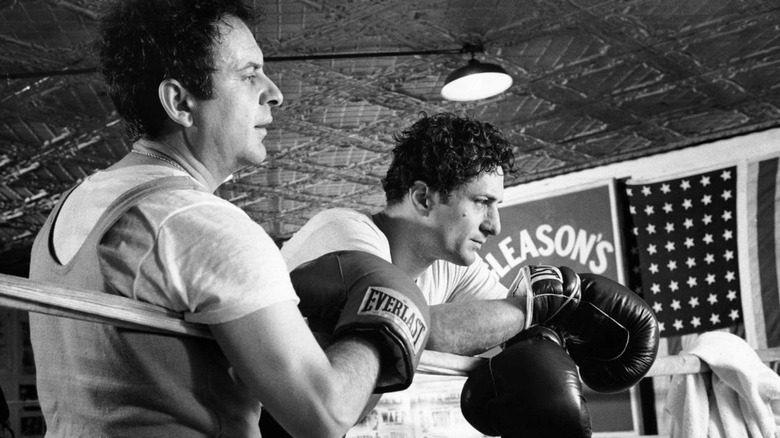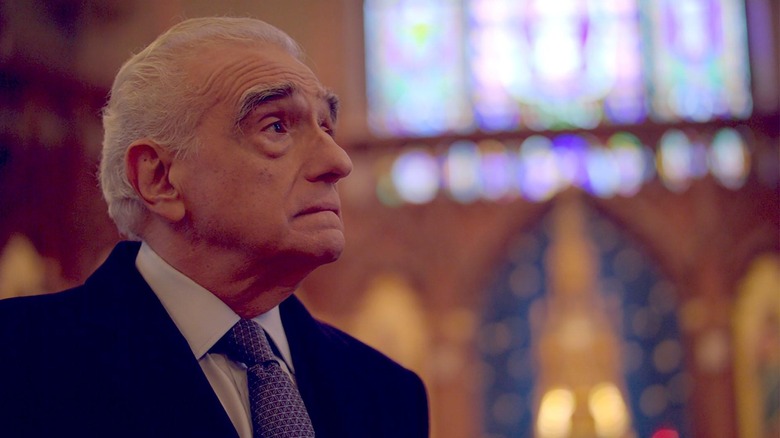The Reason Martin Scorsese Nearly Didn't Make Raging Bull
In lauding Martin Scorsese's seventh feature film, "Raging Bull," about the life of middleweight champ Jake LaMotta, renowned critic Pauline Kael declared it to be "about movies and about violence" as much as it is about boxing. Scorsese, of "Mean Streets" and "Taxi Driver," could speak the languages of rage and guilt fluently, but boxing was a whole other issue. So when Robert De Niro handed the director a copy of LaMotta's 1970 memoir, "Raging Bull: My Story," written with Peter Savage and Joseph Carter, Scorsese dismissed the idea of turning into a project.
Peter Biskind expands on the story in his New Hollywood account, "Easy Riders, Raging Bulls." It was 1974, on the set of "Alice Doesn't Live Here Anymore" with star Ellen Burstyn. The man in the director's chair was wracking his brain to come up with an ending that satisfied both Warner Bros. and his artistic integrity. He was less preoccupied with combat sports and more concerned about whether Burstyn's Alice would settle into housewife-dom or go to fulfill her dream by the film's conclusion.
Years later, Scorsese would make a handful of his most lauded movies, and the black-and-white "Raging Bull" was among them. Not only was the movie's production riddled with complications from script worries to extensive sound mixing, but it almost didn't happen at all.
'This is overwhelming. I can't shoot this.'
Talking with Robert De Niro at the 2019 Tribeca Film Festival, Martin Scorsese admitted he put up a fight:
"When the time came to do 'Raging Bull,' I resisted for a while — for a few years, actually — because I didn't understand boxing. I suddenly realized, 'This is overwhelming, I can't shoot this.'
"Easy Riders, Raging Bulls" paints a picture of a dejected director. With "New York New York" getting a so-so reception upon its release in June 1977, the Italian-American storyteller was angry with the critical fall from grace after the seismic "Taxi Driver" earned such high praise. Undeterred, De Niro brought the novel to producer Irwin Winkler. Biskind writes:
"Winkler agreed to produce it, if they could get Marty to commit. But De Niro had a hard time getting his attention. Scorsese read a couple of chapters, gave the book to Mardik [Martin]. He had no interest in boxing, never went to fights. Besides, LaMotta wasn't much of a boxer. His singular talent lay in his ability to absorb punishment."
Mardik Martin, who co-wrote "Mean Streets" with his friend and fellow NYU alum, wasn't much keener, telling Scorsese that as far as sports pictures go, "the damn thing has been done a hundred times." It wasn't until a few years later that Martin got Scorsese's attention.
'I have this scene that you're gonna like.'
What were the magic words that piqued the director's interest? As Peter Biskind quoted Mardik Martin as saying to Martin Scorsese in "Easy Riders, Raging Bulls":
"I got one good scene that you're gonna like. You have these gladiators, see, just like in Rome, two guys, fighting each other, and you got all these rich people fur coats, tuxedos, sitting in the front row, and Bobby gets punched in the face, and his nose starts to squirt blood, and it splatters all over these rich people's clothes and furs."
And it was off to the races — slowly, excruciatingly. After three early versions of the script failed to come together, United Artists brought "Taxi Driver" scribe Paul Schrader on board to tighten things up, leading to a whole rewrite of the LaMotta journey to include the dynamic between Jake and his brother/manager Joey (played in the film by Joe Pesci). Concerns over a potential X rating (Biskind's book describes how a Schrader-penned jail cell masturbation scene horrified studio execs) led to further rewrites from Scorsese and De Niro. Still it chugged on, and as the film went into principal photography in April 1979, Scorsese felt what Biskind categorized as "a sense of fatality," that this would be his swan song.
We know the rest of Jake LaMotta's big-screen fall from grace. We've seen De Niro pummel and get pummeled. Had it not been for the black-and-white photography, the audience might have imagined blood splatter on their clothes and furs, too. What was nearly an unrealized De Niro passion project, "Raging Bull" opened on November, 14, 1980 to mixed reviews. It gradually earned widespread critical acclaim on top of the accolades it received in real time, to include Oscars for De Niro and editor Thelma Schoonmaker (not Best Picture, though).


